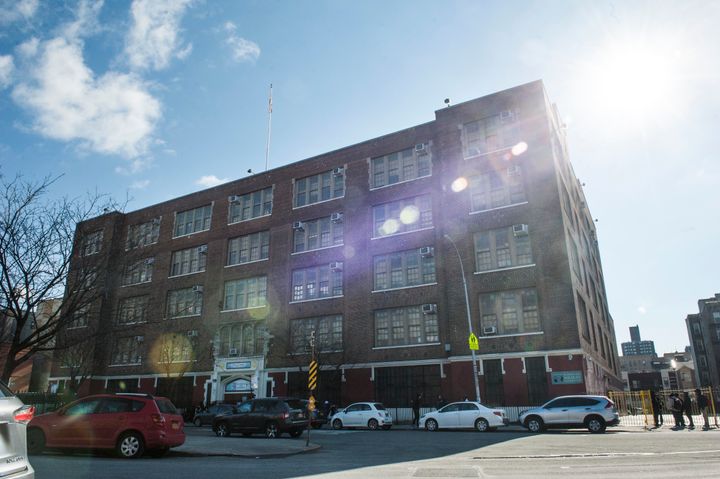
At 10 a.m. on Wednesday, teenagers in more than 3,000 high schools across the United States walked out of their classes to protest gun violence, advocate for gun reform and honor the 17 people who were killed in a mass shooting in Parkland, Florida, last month.
A trickle of students exited the Urban Assembly School for Wildlife Conservation, in the New York City borough of the Bronx, around 10 a.m., but there were no hand-drawn signs, no shouted slogans and no discernable form of protest happening. Before school started that day, several adults entering the school who identified themselves as teachers said they supported a potential student walkout, but didn’t know if students would participate.
A 16-year-old junior at the school, who asked to remain anonymous, stayed in her classroom between 10 and 10:17 a.m. while the national walkout was happening. She said her teacher discouraged her from protesting today.
“The same thing happened at my school with the kid who got stabbed,” she said, referencing a stabbing at Urban Assembly in September that left one student dead and another critically injured, but received scant media coverage outside of New York City.
The junior wasn’t in the classroom where the fatal stabbing happened, but news of the tragic incident quickly rippled through the school. “I was honestly freaking out and crying,” she said. “I felt the hurt that those kids felt.”
“I was honestly freaking out and crying. I felt the hurt that those kids felt.”
- Junior at the Urban Assembly School for Wildlife Conservation, referring to a stabbing at her school.
“This isn’t an apathetic position,” David Kirkland, executive director of NYU’s Metropolitan Center for Research on Equity and The Transformation of Schools, said of students in vulnerable communities who didn’t participate in the National School Walkout.
While he commended the Parkland students for their activism, Kirkland stressed that young people of color don’t enjoy the same freedoms of movement and national protest that white and middle-class students do.
“The young people who are marching across the country next week and who walked out of school today are being seen as heroes when the same is true of people of color,” he explained. “But people of color are seen as thugs or criminals or degenerates.”
Indeed, conservatives have derided and demonized black activists like members of the Black Lives Matter movement and Colin Kaepernick, the former NFL quarterback who was labeled unpatriotic after he kneeled during the national anthem to protest racial injustice.
Students of color have both a heightened risk of being punished for pushing back against authority and a greater likelihood of being the victims of violence than white students.
“Black and brown kids are more likely to be suspended than any other group,” Kirkland said. And if they walk out of school and encounter a police officer, they’re more likely to be arrested, too.
Student safety is a pressing national concern, but as distressing as mass shootings are, they make up a tiny sliver of America’s gun violence epidemic. There were 4,678 homicide victims between the ages of 15 and 24 in 2010 and more than 612,000 young people treated for injuries caused by assault in 2011, according to the U.S. Centers for Disease Control and Prevention. In comparison, 176 children and teenagers have been killed in mass shootings since 1966, according to The Washington Post.
In the grand scheme of things, the Bronx student’s experience with violence is much more representative of violence and trauma in America that young people, especially young people of color, regularly contend with.
“We know that many of these students are going to school and suffer from trauma — anxiety, sleep deprivation related to violence, and yet we haven’t summoned the capacity or courage or humanity in order to respond.”
- David Kirkland, Metropolitan Center for Research on Equity and The Transformation of Schools
That violence is reflected in a school quality survey Urban Assembly conducted the year before the fatal stabbing, which found that only 55 percent of students in the school reported feeling safe in the school’s hallways, bathrooms, locker rooms and cafeteria.
During the 2.5 hours between the start of the school day and the end of the national walkout, at least three public safety cars drove by Urban Assembly, checking in on the students and the building.
Unlike in Newtown, Connecticut, where social services poured into the community, including the resources to tear down the school where the massacre happened and relocate the students, the greater public has paid little attention to other communities reeling from violence, such as the students affected by the stabbing in the Bronx.
“We know that many of these students are going to school and suffer from trauma — anxiety, sleep deprivation related to violence, and yet we haven’t summoned the capacity or courage or humanity in order to respond,” Kirkland said. “There isn’t the same type of human response.”
And next year, the students likely won’t have a school at all. Urban Assembly is one of 14 failing schools that New York City Schools Chancellor Carmen Farina has slated to close this year.
The junior from the Bronx has a lot weighing on her this week. She has until this Friday to identify 12 new high schools that she’d potentially want to transfer to.
Education is an important part of her high school research. So is safety. “I want there to be metal detectors,” she said.
